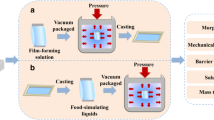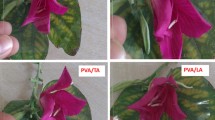Abstract
Biaxially oriented polypropylene (BOPP) coated with acrylic/polyvinylidene chloride (BOPPAcPVDC) and biaxially oriented coextruded polypropylene (BOPPcoex) films have been treated with high power ultrasound (HPUS) while submerged in water. Polymer structure and the surface morphology changes were noticed, and obtained results were correlated with the physical properties of tested materials. In anticipation of sonochemically enhanced reactions, physical–chemical profile of film samples was determined using thermogravimetric analysis, differential scanning calorimetry, Fourier-transform infrared spectroscopy, UV spectrophotometry and environmental scanning electron microscopy. HPUS-treated samples showed better thermal stability than untreated ones. BOPPAcPVDC samples sonicated for a period of 2 and 6 min and amplitudes 50 and 100% showed higher thermal stability as compared to the untreated one. BOPPcoex film surface change occurred after ultrasonic treatment of 6 min and 100% amplitude which was also attributed to the phenomenon of formation of crystalline cluster on the film surface. The implications of the results are used as possibility of HPUS treatment of packaged food.








Similar content being viewed by others
References
Li Y, Li J, Guo S, Li H (2005) Mechanochemical degradation kinetics of high-density polyethylene melt and its mechanism in the presence of ultrasonic irradiation. Ultrason Sonchem 12:183
Gronroos A, Pirkonen P, Heikkinen J, Ihalainen J, Mursunen H, Sekki H (2001) Ultrasonic depolymerization of aqueous polyvinyl alcohol. Ultrason Sonchem 8:259
Leighton TJ (1994) The acoustic bubble. Academic Press, London
Lauterborn W, Hentschel W (1984) Cavitation bubble dynamics studied by high speed photography and holography: part two. Ultrasonics 24(2):59–65
Desaia V, Shenoya MA, Gogateb PR (2008) Degradation of polypropylene using ultrasound-induced acoustic cavitation. Chem Eng J 140(1–3):483–487
Lin YJ, Dias P, Chen HY, Chum S, Hiltner A, Baer E (2008) Oxygen permeability of biaxially oriented polypropylene films. Chem Eng J 140:483–487
Zhu XY, Yan DY, Fang YP (2001) In situ FTIR spectroscopic study of the conformational change of isotactic polypropylene during the crystallization process. J Phys Chem B 105(50):12461–12463
Parthasarthy G, Kannan RM (2002) Rheooptical Fourier transform infrared spectroscopy of the deformation behavior in quenched and slow-cooled isotactic polypropylene films. J Polym Sci Part B Polym Phys 40(22):2539–2551
Sciarratta V, Vohrer U, Hegemann D, Muller M, Oehr C (2003) Plasma functionalization of polypropylene with acrylic acid. Surf Coat Technol 174:805
Socrates G (2001) Infrared and raman characteristic group frequencies: tables and charts, vol 3. Wiley, West Sussex
Arkis E, Cetinkays H, Kurtulus I, Ulucan U, Aytac A, Balci B, Coalk F, Germen ET, Kutluay G, Filhan BC, Balkose D (2015) Characterization of a pearlescent biaxially oriented multilayer polypropylene film. In: Pyrzynski P, Nyszko G, Zaikov GE (eds) Chemical and structure modification of polymers. Apple Academic Press, Oakville
Morent R, De Geyter N, Leys C, Gengembre L, Payen E (2008) Comparison between XPS- and FTIR-analysis of plasma-treated polypropylene film surfaces. Surf Interface Anal 40:597–600
Luongo JP (1960) Infrared study of polypropylene. J App Polym Sci 9(3):302–309
Longo C, Savaris M, Zeni M, Brandalise RN, Coulon Grisa AM (2011) Degradation study of polypropylene (PP) and bioriented polypropylene (BOPP) in the environment. Mater Res 14(4):442–448
Noeli S, de Campos JS (2003) Surface composition analysis of PP films treated by corona discharge. Mater Res 6(2):163–166
Lin YJ, Dias P, Chum S, Hiltner A, Baer E (2007) Surface roughness and light transmission of biaxially oriented polypropylene films. Polym Eng Sci 47(10):1658–1665
Birley AW, Haworth B, Batchelor J (1992) Physics of plastic processing, properties and materials engineering, chapter 9. Hanser, Munich
Wang J, Zhu Y, Fu Y (2013) Abrasion resistance of biaxially oriented polypropylene films coated with nanocomposite hard coatings. App Surf Sci 285(B):697–701
Cao Y, Li H (2002) Influence of ultrasound on the processing and structure of polypropylene during extrusion. Polym Eng Sci 42(7):1534–1540
Miraftab M, Horrocks AR, Mwila J (2002) The influence of carbon black on properties of oriented polypropylene 3. Thermal degradation under applied stress. Polym Deg Stab 78(2):225–235
Roy PK, Surekha P, Rajagopal C, Raman R, Choudhary V (2006) Study on the degradation of low-density polyethylene in the presence of cobalt stearate and benzyl. J App Polym Sci 99(1):236–243
Bhaskar T, Tanabe M, Muto A, Sakata Y, Liu C-F, Chen M-D, Chao CC (2005) Analysis of chlorine distribution in the pyrolysis products of poly(vinylidene chloride) mixed with polyethylene, polypropylene or polystyrene. Polym Deg Stab 89:38–42
Akama T, Yoshioka T, Suzuki T, Uchida M, Okuwaki A (2001) TG–MS analysis of dehydrochlorination of poly(vinylidene chloride). Chem Lett 6:540–541
McNeill IC, Memetea L, Cole WJ (1995) A study of the products of PVC thermal degradation. Polym Deg Stab 49(1):181–191
Peterson JD, Vyazovkin S, Wight CA (2001) Kinetics of the thermal and thermo-oxidative degradation of polystyrene, polyethylene and poly(propylene). Macromol Chem Phys 202(6):775–784
Navarro R, Torre L, Kenny JM, Jimenez A (2003) Thermal degradation of recycled polypropylene toughened with elastomers. Polym Deg Stab 82:279–290
Gómez-del Río T, Rodríguez J (2010) Compression yielding of polypropylenes above glass transition temperature. Eur Polym J 46:1244–1250
Moore EP Jr. (1996) Polypropylene handbook. Hanser Publications, Vienna
Karger-Kocsis J (1999) Polypropylene: an A–Z reference. Kluwer, Dordrecht
Wong AC-Y, Lam F (2002) Study of selected thermal characteristics of polypropylene/polyethylene binary blends using DSC and TGA. Polym Test 21:691–696
Price GJ, White AJ, Clifton AA (1995) The effect of high-intensity ultrasound on solid polymers. Polymer 26(36):4919–4925
Ščetar M, Kurek M, Režek Jambrak A, Debeaufort F, Galić K (2017) Influence of high power ultrasound on physical-chemical properties of polypropylene films aimed for food packaging: barrier and contact angle features. Polym Int 66(11):1572–1578
Author information
Authors and Affiliations
Corresponding author
Rights and permissions
About this article
Cite this article
Ščetar, M., Kurek, M., Režek Jambrak, A. et al. Effect of high power ultrasound on physical–chemical properties of polypropylene films aimed for food packaging: structure and surface features. Polym. Bull. 76, 1007–1021 (2019). https://doi.org/10.1007/s00289-018-2416-9
Received:
Revised:
Accepted:
Published:
Issue Date:
DOI: https://doi.org/10.1007/s00289-018-2416-9




